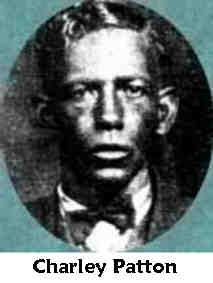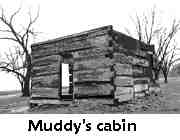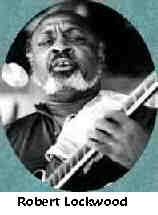
No one will argue
that the life of a black man in the 19th and 20th centuries has
been burdensome. These days we can only imagine how difficult
it must have been to be so oppressed. Many whites saw blacks as
intruders with little to offer other than cheap labor. However,
the black musician seemed to enjoy a slightly better lifestyle
over other black workers, which is evidence of a change in this
opinion. This section explores examples and causes behind the
improved lifestyles of black musicians and how they signal the
genesis of an improvement in race relations between whites and
blacks.
Listen
to Sammy Blue, a blues musician from Atlanta, GA, describe blues
originating as a form of therapy for blacks.
Almost as soon as
the slaves arrived, they began forming bands. These bands featured
a variety of instruments including homemade lutes, percussion
instruments, and flutes or fifes. They were also the artistic
force behind the blackface minstrel shows that were soon to become
greatly popular. Experts find evidence of white appreciation for
early black music in the way whites treated those workers who
were musically talented. Robert Palmer, author of Deep Blues,
mentions the Senegambians in particular who were admired for their
musical ability and allowed special privileges on many plantations.
They were granted light housework while slaves from other African
regions were made to complete the harsh fieldwork1.
In the early 19th century, advertisements would point out the
musical talents of the slaves who were for sale knowing that would
put them in higher demand2.
This treatment continued
into the twentieth century. The farmers who were also musicians
were paid an additional amount of money, however small it was,
and given food and whiskey for their services. Historians again
presume that this compensation and preferential treatment was
more evidence that whites appreciated the musical talent of these
blacks. The white landowners even supported the black Saturday
night dances, reportedly because they felt that blacks needed
an outlet for their energy. Congregating at parties was a good
way for blacks to relax and let loose after a week of tough labor3.
Blues music was not
only an essential element of many religious and secular events
for blacks, but it was a substantial source of entertainment for
whites as well. Performers were able use the same repertoire when
entertaining either race. Robert Wilkins, a country blues artist
from Mississippi, began his career as a performer in 1913 while
entertaining whites and blacks with a similar collection of songs4.
Sam Chatmon, another country blues artist from Mississippi and
a member of the famous Chatmon family, once said, "Mighty
seldom I played for coloreds. They didn't have nothing to hire
you with5." The main focus of the bluesmen at
this time was to keep the audience happy, which meant playing
anything they wanted to hear, whether it be spirituals, dance
tunes, or popular hits. Blind Lemon Jefferson, a Texan who became
very well known for his acoustic blues during the years prior
to the Depression, impressed white and black musicians and audiences
alike6. It was his popularity in 1926 that revealed
to the record companies that a rural blues market existed7.
As with the Senegambians
years before, those who possessed the talent during this time
period enjoyed a better life. Though it never made a man rich,
the blues of this early period offered a lifestyle which was considerably
more comfortable than that of a farmer, the typical line of work
during this time. It allowed its practitioners to make more of
their own decisions. A musician could come and go as he pleased
and never had to take orders from a man paying him next to nothing
to work his fingers to the bone8. Listen to one of the reasons Chicago
Bob, a blues artist from Baton Rouge, LA, became a musician.
 Charley Patton is an example
of a bluesman living as a semi-professional entertainer, glad
to escape the hard field labor9. Will Dockery was the
owner of a plantation in Sunflower County, Mississippi, where
Charley Patton's father moved his family around 1897. Dockery's
plantation was a town in itself. He had his own stores, cotton
gins, post office, medical clinic, cemetery, and train station.
He had no use for the music of the blacks, but his attitude was
not the standard of that day. Conversely, Dockery's good friend
William Howard Stovall Charley Patton is an example
of a bluesman living as a semi-professional entertainer, glad
to escape the hard field labor9. Will Dockery was the
owner of a plantation in Sunflower County, Mississippi, where
Charley Patton's father moved his family around 1897. Dockery's
plantation was a town in itself. He had his own stores, cotton
gins, post office, medical clinic, cemetery, and train station.
He had no use for the music of the blacks, but his attitude was
not the standard of that day. Conversely, Dockery's good friend
William Howard Stovall  employed The Mississippi Sheiks,
which included as part of its lineup Bo Carter, Lonnie Chatmon,
and Walter Vinson in different arrangements, to act as personal
songsters to him. Patton was eventually discharged from Dockery's
plantation and was employed by George Kirkland, another plantation
owner just a few miles down the road, who put him to work specifically
as a musician and released him from other work10. employed The Mississippi Sheiks,
which included as part of its lineup Bo Carter, Lonnie Chatmon,
and Walter Vinson in different arrangements, to act as personal
songsters to him. Patton was eventually discharged from Dockery's
plantation and was employed by George Kirkland, another plantation
owner just a few miles down the road, who put him to work specifically
as a musician and released him from other work10.
Muddy Waters also
resided on Stovall's plantation in a cabin  that transformed into a juke
house on weekends. Muddy was famous for making the best moonshine
for miles around. His juke house was moderately, yet steadily,
lucrative which was a welcomed addition to the 22 ½ cents
an hour he made as a tractor driver. He also brought in a little
extra by selling his liquor to white supervisors and performing
at house parties11. that transformed into a juke
house on weekends. Muddy was famous for making the best moonshine
for miles around. His juke house was moderately, yet steadily,
lucrative which was a welcomed addition to the 22 ½ cents
an hour he made as a tractor driver. He also brought in a little
extra by selling his liquor to white supervisors and performing
at house parties11.
Numerous artists echo
this story of entertaining white people. Jesse Mae Hemphill remembers:
My granddaddy
would play all kinds of songs…All of the white folk were
crazy about him and the children. He was friendly with everybody,
but he would play more for white people round here. At their
houses for them big dances, the rich white folk would get him
to play, and all three of the girls and me, they would go tell
him, let them all come over there. They liked to do waltzes.
Square dances. Granddaddy would call and they would do it…When
it was cold we'd go to somebody's house, we didn't care who they
was, we'd go up and knock and tell them we had music - y'all
play music, come on in, play me a piece. We'd go in and play
and sometimes stay two, three days - they glad to have us. Wouldn't
charge us or nothing12.
Honeyboy Edwards describes
white patrons of those days:
It was some white
people down there at the time was mean, and I played for a lot
of white dances down there and they treated me real nice, they'd
bring me back home in the car, pay me what they said they was
gonna pay me, give me my drinks and my meal free13.
 Robert Lockwood remembers life in the early
1900s: Robert Lockwood remembers life in the early
1900s:
"Where I
grew up, my people was, you could say, middle class livers -
everybody had their own farms and stuff, so nobody forced nobody
to go to no field. People on both sides of my family had their
own little plantations. But I ran into some of that shit in Mississippi,
when we got locked up for vagrancy. They would just pick you
up - it was a law-breaking thing to not be in the field. They
locked us up in Sardis, MS. We did not have to do any work, nothing
like that - they just locked us up because in that part of MS
they did not have any juke boxes, and they locked us up to hear
us play! I understood that after it was all over, they locked
us up because they didn't have music and didn't allow jukeboxes
in Sardi, Como, and Batesville. They locked us up because we
were sounding very good, and they would take us serenading, the
people would give us money and they would give the money to us.
When they turned us out of jail we had over $500 apiece, that
was a lot of money at that time. And we were eating in restaurants.
It was…strange14."
Listen to
a comment made by Chicago Bob about the treatment Louis Armstrong
received while playing in the homes of whites.
1. Palmer,
32-33
2. Davis, 27-28
3. Titon, 24, 57-59
4. Titon, 30
5. Davis, 27-28
6. Titon, 30
7. Davis, 38
8. Titon, 57-59
9. Titon, 58
10. Davis, 58
11. Palmer, 3-4
12. Trynka, 22-23
13. Trynka, 23
14. Trynka, 34-35
 Back to top Back to top
|
